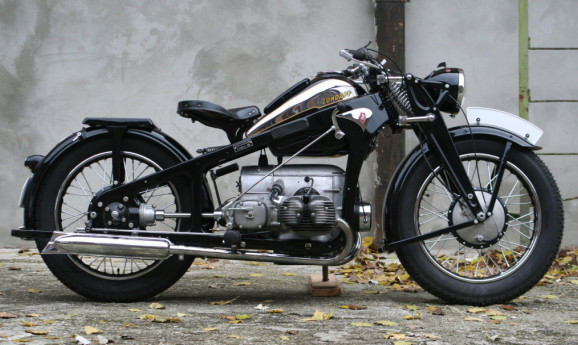
Zündapp KS600 1941
Frame Number: 516862 Engine Number: 516862
Year: 1941 ccm: 600
In 1932, Hans Friedrich Neumeyer planned a completely new motorcycle range of five types for the Nuremberg Zündapp factory, and to realize this he hired Richard Küchen, the famous engine and vehicle designer, as chief designer. He was given the task of developing a completely new motorcycle model range, the "K" series ("K" for box frame, shaft drive). Intensive design work had to be carried out on the single-cylinder two-stroke models with 200 and 350 cm3 displacement and the initially side-controlled, 400 and 500 cm3 displacement two-cylinder four-stroke boxers with cardan shaft in a steel profile frame as well as top-controlled four-cylinder boxers with 600 and 800 cm3 displacement. Key details of all of Zündapp's kitchen designs were chain gears, intake tract integrated into the block, split connecting rod roller bearings, hydraulic dampers in the front wheel fork, to name just a few.
At the International Automobile and Motorcycle Exhibition in Berlin in 1933, the new Zündapp models were very well received because of their smooth and sweeping lines. Richard Küchen created the low-noise motorcycle with cardan drive, chain gear and ball gearshift, pressed steel frame and boxer engines from 400 cc to 800 cc four-cylinder.
The Zündapp KS600 machine had a two-cylinder, four-stroke boxer engine with a Fischer-Amal carburettor, a 6-volt ignition light system, multi-disc dry clutch, a four-speed chain transmission and shaft drive. According to the operating instructions, switching was carried out either by hand or by foot. The ignition had to be adjusted by hand. The front wheel hung on a trapezoidal fork with two compression springs and initially a friction shock absorber, later a hydraulic damper. Apart from the fork, only the saddle was sprung with two springs. The frame was rigid at the back. The tank held 15 liters, which enabled a range of up to 300 kilometers with a consumption of around 5 liters per 100 kilometers.
This example, which has been in a private museum for the past few years, has a great, rich sound and a powerful motor.





















